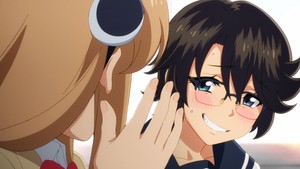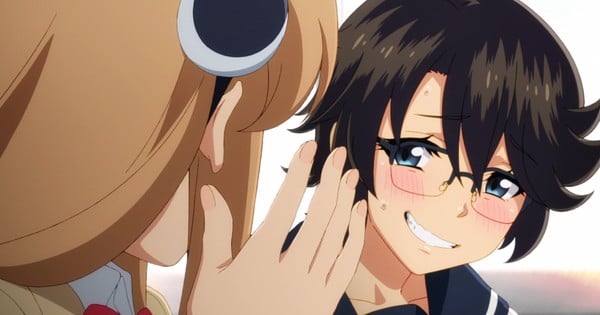Curated From www.animenewsnetwork.com Check Them Out For More Content.
How would you rate episode 1 of
Shy ?
Community score: 4.2
How would you rate episode 2 of
Shy ?
Community score: 4.2
How would you rate episode 3 of
Shy ?
Community score: 4.1

© 実樹ぶきみ(秋田書店)/SHY製作委員会
One day, people with supernatural powers suddenly appeared, ushering in a new era of peace and eventual supervillainy, yada yada yada—we all know how this story goes. Superhero yarns in the modern age need a hook baited with a tastier morsel than “Wouldn’t it be crazy if a normal guy could fly?” This is the first thing Shy gets right. The show smartly skims past the stage setting in its first minute, leaving plenty of room to focus on the real draw: a teen girl coping with crippling anxiety as she carries out her heroic duties.
Shy begins with Teru doing a godawful job of hyping up the scattered crowd of kids waiting for the super sentai team they actually came to see. It’s not an action scene, and it definitely doesn’t make Teru look cool. It does, however, reveal the narrative’s priorities. This is a drama about Teru’s interiority, and it focuses specifically on how her psychological struggles intersect with her ambition to use her powers to help people. I can imagine Teru wearing thin on certain audiences, which is an endorsement of how she’s written. Speaking as someone who went through adolescence with comparable levels of insecurity and self-flagellation, I find Teru’s thought processes wonderfully authentic. While it does mine her shyness for relatable jokes, a la some recent cringe comedies like Bocchi the Rock!, Shy‘s overall angle is much more severe. It really grapples with the almost crippling weight of responsibility thrust onto Teru’s small frame.
This is evident in the premiere, which focuses not on her valiant rollercoaster rescue but on its aftermath. Teru cannot think about anything she got right; she can only dwell on the single thing that went wrong. This is unsurprisingly exacerbated by a news and social media landscape that thrives on catastrophizing, feeding Teru’s spiral inward and downward. Self-hatred similarly defines the landscape of the second episode, where Iko’s guilt over the death of her parents transforms her heart into a jagged mess of suicidal ideation. This is also where we see Teru’s true power. Her anxiety and depression attune her to those facets in other people. While it can be hard to extend sympathy to oneself if one knows that pain, one usually doesn’t want the people they care about to experience it alone. If Shy is a story about wounded hearts turning into weapons, it’s also about wounded hearts turning into heroes.
In short, I really like where Shy is at thematically right now. It’s not blazing trails with its psychological approach to superheroism, but it feels like it has its own identity. Teru is the most important component of that. Despite her flaws and uncertainty, she strives to improve, and I can believe that her struggles are written from a perspective that fundamentally understands her strengths and foibles. That perspective also seems to understand the importance of confronting pain and trauma honestly. Note how Stigma couches his villainy in enabling language, saying that Iko’s wounds essentially give her the right to do as she pleases, even if it hurts others. You see this rhetoric all the time when people are justifying their bad behavior. On the other hand, Teru knows that being in pain gives one more reason to help others avoid it.
I’m also eager to see how that psychological perspective extends to the other heroes in the bunch. Spirit has been a dependable mentor to Teru, but surely there’s more to her love of vodka than her being Russian. Meanwhile, Stardust’s heavily public persona makes him an interesting foil for Teru’s antisocial habits, as well as a fitting friendly(?) adversary. I suspect there’s more going on than a simple battle of good versus evil, too. My eyebrow rose quite a bit when Unilord revealed that her bracelets work on the same principle as Stigma’s rings.
Speaking of Stigma, he has a great, menacing introduction that exhibits the best of the anime’s style. The overall visual direction leans into the comic book origins with plenty of palette shifts, Ben-Day dots, retro-inspired costumes, and conspicuous paneling choices. The paneling is especially reminiscent of Masaomi Andō‘s prior work on Astra Lost in Space, but it’s used more aggressively and appropriately here. Stigma’s appearance includes striking storyboards that draw parallels between his cloying fingers, creepy umbrella ribs, and craggy crystals. These horror-inspired choices match the narrative’s swerve into the heart of darkness and herald a production that is willing to prioritize emotional realities over physical ones. My major complaint about the visual fundamentals is that I’m not a huge fan of the color design in the “normal” scenes. I’m not an artist, so I can’t articulate it as well as I’d like, but something about the palette doesn’t mesh well for me, like it’s not quite at the right saturation level for the colors being used.
However, I can put up with some ugly colors if it means seeing Teru overcome the demons in her own heart as she helps others overcome the demons within theirs. She’s a great and immediately likable protagonist, and I’m glad the story doesn’t shy away from her faults or try to make them overly palatable. She needs to be a little frustrating because that makes scenes like her wholesome date with Iko all the more impactful. Much like Unilord’s batch of borscht, the conspiratorial stuff about the league of heroes is nice to have simmering in the background. Still, the main course for me is a narrative about people helping each other heal from trauma. That’s heavy stuff, so I appreciate the light comedy sprinkled throughout. The yuks aren’t overbearing; they help hold the show’s tone from descending too far into dourness. Shy is exceptionally well-balanced so far.
My final note is that I have not read the manga, so unless I say otherwise, I’ll approach this production as an anime-only newbie in the future. As of now, I don’t think that’s a bad place to be, either. I can’t contrast it against the source, but to me, the anime’s direction seems to understand the cogs turning beneath the narrative’s surface. While I don’t know what twists and turns are in store for Teru, these opening three episodes have laid a strong foundation I’m eager to see built up.
Rating:
Shy is currently streaming on
Crunchyroll.
Steve is on Twitter while it lasts. He is a recovering shy kid. You can also catch him chatting about trash and treasure alike on This Week in Anime.

